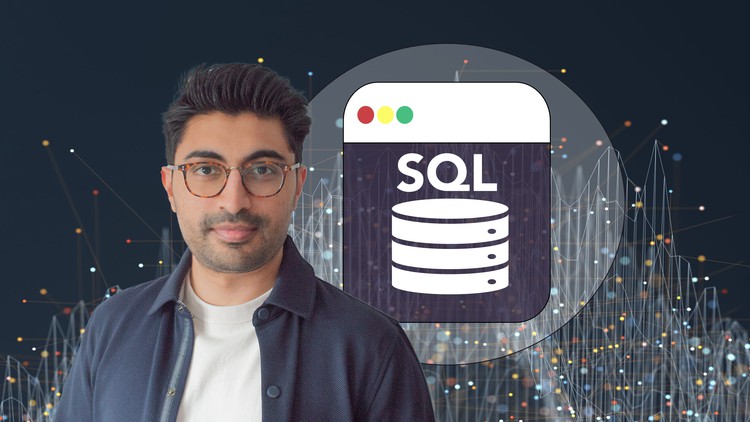Want to learn one of the most in-demand skills in the business and technology sector?
Then this course is for you!
SQL skills are highly marketable everywhere, especially in companies like Netflix, Facebook, Amazon, Google… the list goes on and on… The simple fact is that if you want to do any work involving data, then the chances are that you need to know SQL!
This course has been designed for:
Get Instant Notification of New Courses on our
Telegram channel.
- Individuals with no prior experience in SQL and looking to make that step to develop their skills in this highly sought after programming language
- Those with some experience looking to brush up on their SQL knowledge
No downloads or software installation required! We will be using Oracle APEX which is a web-based application – you will be set up with your own virtual database hosted on the cloud! Although we will be using Oracle APEX the course has been designed to highlight key differences between some of the main Database Management Systems such as MySQL and Microsoft SQL Server, so what you learn in this course can be applied across all platforms supporting SQL.
The lectures in this course are arranged into short, bite-sized chunks. The course is designed to be comprehensive, but also concise in order to make the learning experience as easy as possible. Every technical section of the course will be rounded off with quizzes / assignments and give you an opportunity to develop your practical skills.
The course will provide students with an extensive Question Bank section which is full of questions and walkthroughs designed to emulate real world scenarios and combine together all of the different SQL clauses, operations and commands taught in this course!
In this course you will learn about:
- Data Definition Language Commands such as CREATE, DROP, TRUNCATE, ALTER and RENAME
- Data Query Language Commands using the SELECT statement
- Data Manipulation Commands such as INSERT, UPDATE and DELETE
- Data Control Language Commands such as GRANT and REVOKE
- Transaction Control Language commands such as COMMIT and ROLLBACK
- Data Types
- Qualifying Column Names
- Aliasing Columns and Tables
- Row Level Functions
- Aggregation Functions
- The Where Clause
- The Group By and Having Clauses
- The Order By Clause
- Single Table and Multiple Table Joins
- SET Operators
- Subqueries
- Database Constraints
- Relational Databases and Data Model Design including STAR and SNOWFLAKE Schemas
- Views
Intoduction To The Course And Set Up
Course Overview
Getting Set Up On Oracle APEX
Oracle APEX Overview
Exploring The Countries Sample Dataset
Important infomation relating to Oracle APEX Sample Datasets
What Is SQL?
Tables
Basic Database Terminology
Your First SQL Query
Quiz
Data Types
Section Overview
String Data Types
Numerical Data Types
Date Data Types
The Describe Statement
Simple Mathematical Operators
Guidance And Documentation On Data Types
Useful External Links On Data Types
Quiz
SQL Commands
Section Overview
The 5 Types of SQL Commands
Data Query Language
Select Distinct
Data Definition Language
Note On String and Numerical Values
Data Manipulation Language
Data Control Language
Transaction Control Language
Assignment Questions
Assignment Solutions Walkthrough
Assignment Solutions (SQL Code)
Qualifying Columns And Aliasing Table Names
Section Overview
Qualifying Columns
Aliasing Table Names
Qualified vs Unqualified Objects
Quiz
Operators And The Where Clause
Section Overview
Operators And The Where Clause
Some Examples Using The Where Clause
An Important Note About Case Sensitivity In SQL
Introduction To The Case Statement
Examples With The Case Statement
Revisiting The DML Update Command
Assignment Questions
Assignment Solutions Walkthrough
Assignment Solutions (SQL Code)
Date, String And Mathematical Functions
Section Overview
Installing The Employees (EMP/DEPT) Sample Dataset
The CAST Function
Date Values and Formatting
Date Functions
String Functions
Mathematical Functions
Useful External Links On Functions
Assignment Questions
Assignment Solutions Walkthrough
Assignment Solutions (SQL Code)
Aggregate Functions And The Group By, Having & Order By Clauses
Section Overview
Aggregate Functions
Count(*)
Aggregate Functions And The Where Clause
Aggregate Functions And Group By
Single Column Group By
Multi Column Group By
Non-Aggregated Columns
Group By And The Having Clause
Group By On Numerical Fields
Order By
Order Of Execution
Assignment Questions
Assignment Solutions Walkthrough
Assignment Solutions (SQL Code)
Joining Tables
Section Overview
Introduction to the Join Operation
Simple Join
Joining Multiple Tables
Joining On Multiple Columns
Assignment Questions
Assignment Solutions Walkthrough
Assignment Solutions (SQL Code)
Query Order Of Execution And Subqueries
Section Overview
SQL Query Order Of Execution
Fetch, Limit And Top
Subqueries
Subqueries And Joins
Assignment Questions
Assignment Solutions Walkthrough
Assignment Solutions (SQL Code)
Relational Data Model Basics And Database Constraints
Section Overview
Relational Databases
Fact And Dimension Tables Revisited
Star And Snowflake Schemas
Types Of Relationships
Primary Key and Foreign Key Constraints
Quiz
The Question Bank: Bringing It All Together
Section Overview
Installing The Customers Sample Dataset
Important Note On Sample Datasets
Question 1
Question 1 Solution Walkthrough
Question 1 Solution (SQL Code)
Question 2
Question 2 Solution Walkthrough
Question 2 Solution (SQL Code)
Question 3
Question 3 Solution Walkthrough
Question 3 Solution (SQL Code)
Question 4
Question 4 Solution Walkthrough
Question 4 Solution (SQL Code)
Question 5
Question 5 Solution Walkthrough
Question 5 Solution (SQL Code)
Question 6
Question 6 Solution Walkthrough
Question 6 Solution (SQL Code)
Question 7
Question 7 Solution Walkthrough
Question 7 Solution (SQL Code)
Question 8
Question 8 Solution Walkthrough
Question 8 Solution (SQL Code)
Question 9
Question 9 Solution Walkthrough
Question 9 Solution (SQL Code)
Other Useful Bits
Inserting Comments Into Your Code
Views
